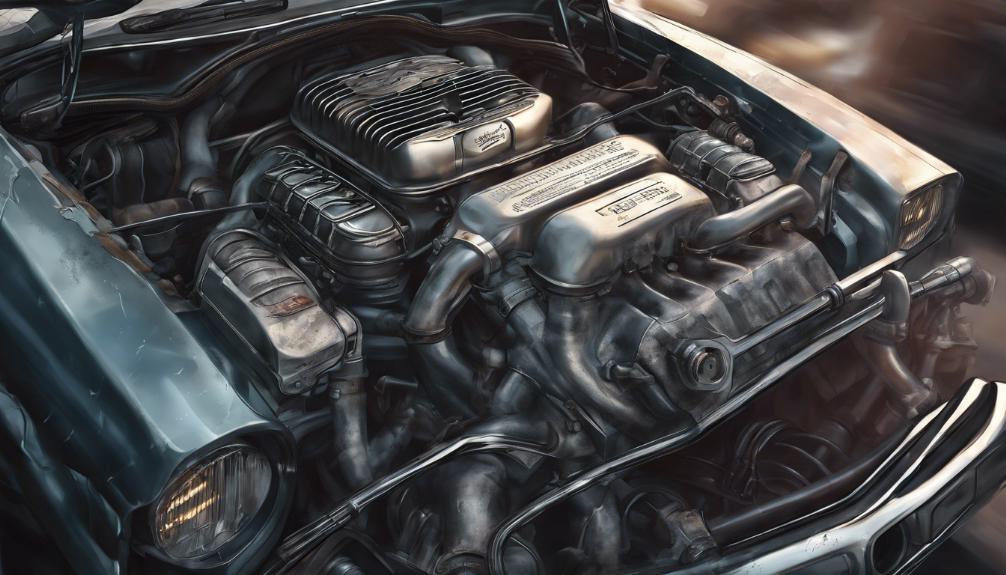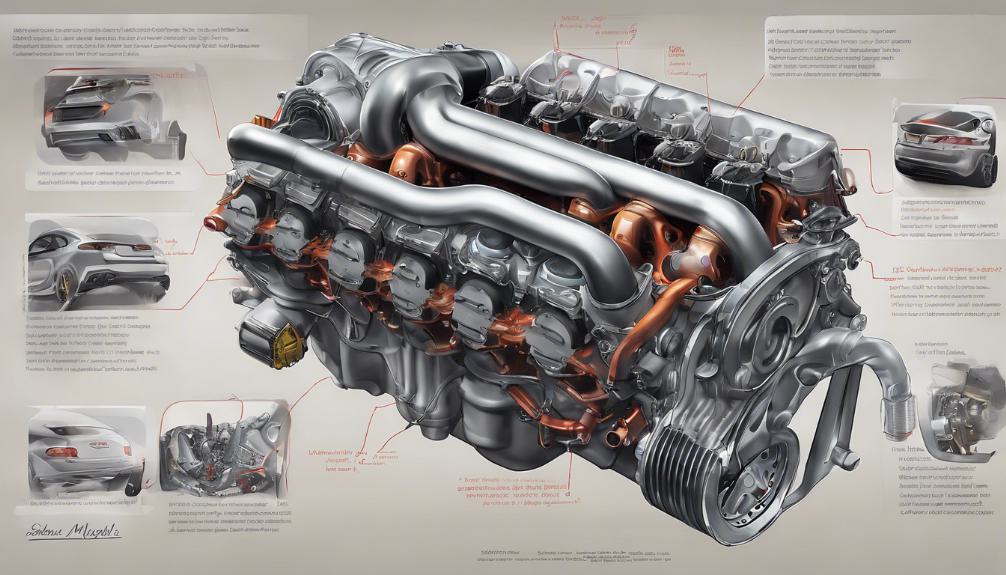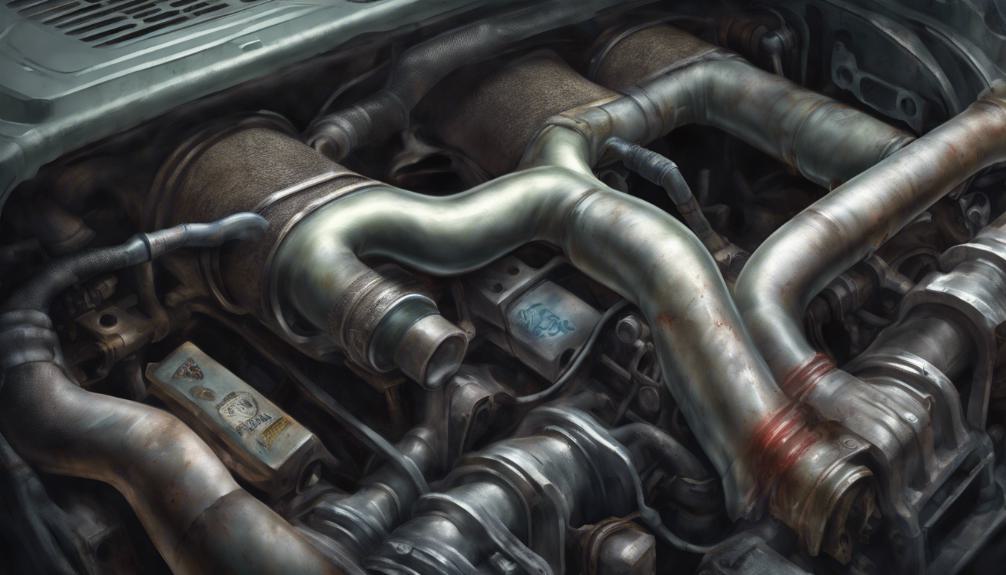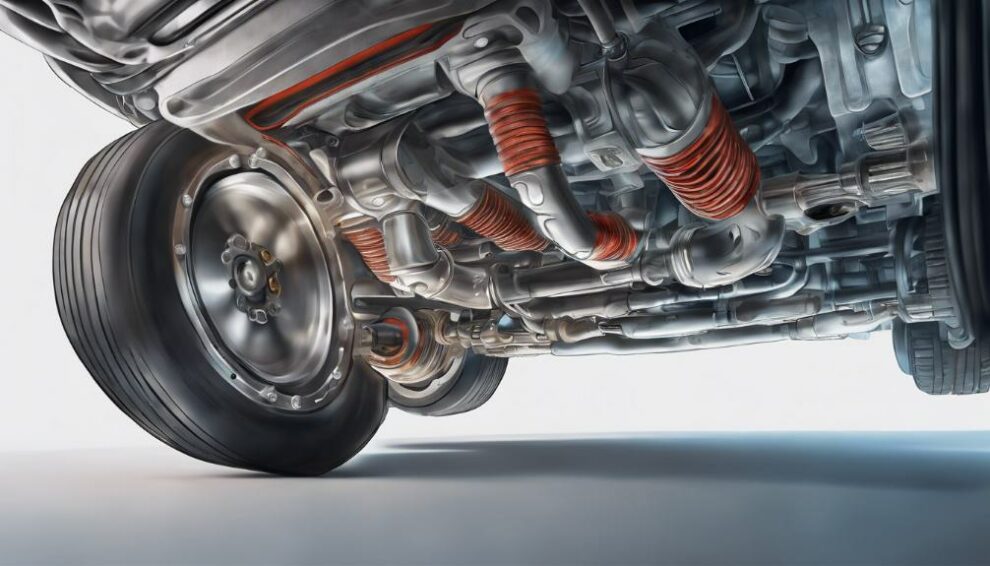The exhaust manifold is located at the engine’s cylinder head, enhancing exhaust flow by collecting gases and channeling them in the direction of the converter.
Its design influences engine performance and fuel efficiency, making proper maintenance essential to prevent leaks and harmful emissions.
Connecting to the cylinder head along the engine block, the manifold plays a vital role in emission control and noise reduction, with regular inspections recommended for issue detection.
Understanding its location variations aids in diagnosing problems, while knowing its placement near the engine block optimizes performance and maintenance.
Water in engine oil can signal manifold issues, highlighting the importance of regular maintenance checks.
Key Takeaways
- The exhaust manifold is located at the engine’s cylinder head.
- It connects to the engine block using bolts for a tight seal.
- Variations exist in placement based on vehicle model and materials.
- Understanding its location aids in maintenance and issue diagnosis.
- Visual guides assist in identifying connection points for troubleshooting.
Understanding the Exhaust Manifold’s Role

Understanding the exhaust manifold‘s role is essential for grasping how it optimizes engine performance and efficiency.
Situated at the engine’s cylinder head, the exhaust manifold plays a significant part in enhancing exhaust flow.
By collecting exhaust gases from multiple cylinders and channeling them into a single pipe leading to the catalytic converter, the manifold guarantees efficient evacuation of spent gases from the engine.
The design of the manifold directly impacts the engine’s overall performance and fuel efficiency.
A well-designed manifold promotes smooth exhaust flow, reducing backpressure on the engine, which can enhance power output.
Proper maintenance of the exhaust manifold is crucial to prevent leaks that could compromise engine function and increase harmful emissions.
Understanding how the exhaust manifold functions at the cylinder head provides valuable insights for diagnosing and addressing potential issues within the vehicle’s exhaust system, ensuring top performance and environmental compliance.
Engine Block Connection Points
Positioned along the side of the engine block, the exhaust manifold connects to the cylinder head to gather exhaust gases from the engine’s cylinders.
The manifold installation involves securing the manifold to the cylinder head using bolts and ensuring a tight seal to prevent exhaust leaks.
This connection point plays a crucial role in the proper functioning of the exhaust system, as it channels the collected exhaust gases in the direction of the exhaust system for emission control and noise reduction.
Proper installation and sealing at this point are essential to maintain peak engine performance and efficiency.
The exhaust system connection at the engine block allows for efficient removal and replacement of the exhaust manifold during maintenance or repairs.
Ensuring a secure and sealed connection at this point is essential in preventing exhaust leaks, which can lead to decreased engine performance and potential safety hazards.
Regular inspection of the connection points is recommended to detect and address any issues promptly.
Exhaust Manifold Location Variations

The location of the exhaust manifold can vary depending on the vehicle model, with some designs placing it at the front or rear of the engine.
This variation is influenced by factors such as the vehicle’s layout and engine configuration. The materials used in manufacturing the manifold also play a role in its location.
Different materials have varying heat dissipation properties, affecting where the manifold can be placed for best performance.
Manifolds made of cast iron, for example, tend to handle high temperatures well, allowing them to be positioned closer to the engine block.
On the other hand, manifolds constructed from stainless steel or ceramic coatings may offer better heat dissipation, enabling them to be located further away from the engine.
Understanding these variations is essential for diagnosing issues related to exhaust flow, back pressure, and overall engine efficiency.
Familiarizing yourself with the manifold’s location and materials will aid in maintaining and repairing your vehicle effectively.
Importance of Knowing Manifold Placement
Locating the exhaust manifold near the engine block plays an essential role in optimizing engine performance by efficiently collecting exhaust gases from the cylinders.
Understanding the significance of this placement is important for maintaining your vehicle’s health.
Knowing the manifold’s position allows you to execute maintenance techniques effectively, ensuring the exhaust system operates smoothly.
Proper placement also enables you to explore performance upgrades that can enhance your engine’s overall functionality.
By being aware of where the exhaust manifold is located, you can diagnose issues accurately and address any potential problems promptly.
Visual guides can assist you in identifying the manifold’s connection points, aiding in both maintenance and upgrades.
Whether you’re looking to improve your vehicle’s performance or simply ensure its proper functioning, knowing the manifold’s placement is key.
Stay informed, and you’ll be better equipped to handle any exhaust system issues that may arise.
Troubleshooting Exhaust Manifold Issues

If you notice water in your engine oil, it could be a sign of potential exhaust manifold issues. Water contamination in the oil can indicate worn gaskets on the exhaust manifold, leading to water leakage into the system.
Troubleshooting techniques for exhaust manifold problems often involve inspecting gaskets and water jackets for signs of leaks or damage.
Common issues with exhaust manifolds include water contamination without visible leaks, underscoring the importance of a thorough examination of the system.
Regular exhaust manifold maintenance is essential to prevent water damage and costly repairs. Checking for leaks and rust, especially in the winter, can help avoid potential issues related to water infiltration.
Understanding the water flow path within the exhaust manifold system is vital for proactive maintenance and early detection of problems.
By staying vigilant and conducting regular inspections, you can mitigate exhaust manifold issues before they escalate into significant concerns.
As an Amazon Associate we earn from qualifying purchases.










